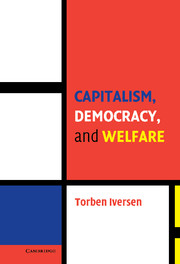Book contents
- Frontmatter
- Contents
- Tables
- Figures
- Acknowledgments
- Capitalism, Democracy, and Welfare
- Part I Welfare Production Regimes
- 1 A POLITICAL ECONOMY APPROACH TO THE WELFARE STATE
- 2 A BRIEF ANALYTICAL HISTORY OF MODERN WELFARE PRODUCTION REGIMES
- Part II Political Foundations of Social Policy
- Part III Forces of Change
- Bibliography
- Index
- Titles in the series
1 - A POLITICAL ECONOMY APPROACH TO THE WELFARE STATE
Published online by Cambridge University Press: 05 September 2012
- Frontmatter
- Contents
- Tables
- Figures
- Acknowledgments
- Capitalism, Democracy, and Welfare
- Part I Welfare Production Regimes
- 1 A POLITICAL ECONOMY APPROACH TO THE WELFARE STATE
- 2 A BRIEF ANALYTICAL HISTORY OF MODERN WELFARE PRODUCTION REGIMES
- Part II Political Foundations of Social Policy
- Part III Forces of Change
- Bibliography
- Index
- Titles in the series
Summary
Printing is one of the world's oldest industries, and typography is one of the oldest occupations in the industrial economy. Typographers essentially transformed stacks of typed and handwritten manuscripts into a form that permitted the mass production of books, newspapers, and journals. Half technicians and half craftsmen, typographers were highly skilled, well paid, and proud harbingers of Gutenberg's revolutionary invention. However, the craft was radically transformed over time: first from “hot-metal” typesetting to “analog” typesetting and then to digital CRT (cathode ray tube) and laser image-setting. In the process of change, previous typesetting skills were swept aside in a matter of a decade or two, and large numbers of typesetters and other printing production workers lost their jobs – many by an invention that the printed word helped set in motion: the computer. Lead molds, printing plates, and all the other paraphernalia that went into the original printing processes were retired to the dusty shelves of industry museums. But retirement was not an option for the majority of typographers whose livelihood depended on using the skills they had acquired through long apprenticeships and years of learning by doing.
The depth of desperation these workers felt as their industry was transformed – manifested in bitter strikes across the developed world – can be loosely conceptualized as a product of the nontransferability of their skills and the speed with which their skills were rendered obsolete by new technology minus the availability of public policies such as unemployment insurance, public health insurance, pensions, retraining programs, and public job creation that all cushion the effects of skill redundancy.
- Type
- Chapter
- Information
- Capitalism, Democracy, and Welfare , pp. 3 - 29Publisher: Cambridge University PressPrint publication year: 2005

